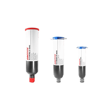LOCTITE ECCOBOND UF8806G
- Reduced thermal stress
- Superior adhesion
- Excellent flow characteristics
Product Description
Henkel is discontinuing production of LOCTITE ECCOBOND UF 8806G and LOCTITE ECCOBOND UF 8806H as of September 30, 2024. The last date to place orders for the Product is June 30, 2024. Looking for direct alternatives? LOCTITE ECCOBOND UF 8830S is the closest standard material
LOCTITE ECCOBOND UF 8806G high flow, liquid encapsulant is designed to improve the thermal cycling and reliability performance of ceramic flip chip devices. It is formulated using a proprietary Moisture Resistant Cyanate Estser (MRCE) resin.
LOCTITE ECCOBOND UF 8806G will reduce thermal stress between substrate and chip interconnects. It will form a hard black colored polymer when sufficiently cured. This material is designed to achieve JEDEC Level 1 reliability standards with ceramic substrates
Cure Schedule
- 45 minute ramp to 195°C + 60 minutes @ 195°C
- 30 minute ramp to 165°C + 180 minutes @ 165°C
Technical Specifications
| Thermal Properties | |
| Glass Transition Temperature (Tg) Glass Transition Temperature (Tg) The glass transition temperature for organic adhesives is a temperature region where the polymers change from glassy and brittle to soft and rubbery. Increasing the temperature further continues the softening process as the viscosity drops too. Temperatures between the glass transition temperature and below the decomposition point of the adhesive are the best region for bonding. The glass-transition temperature Tg of a material characterizes the range of temperatures over which this glass transition occurs. | 136 °C |
| Physical Properties | |
| Thixotropic index Thixotropic index Thixotropic Index is a ratio of a material s viscosity at two different speeds in Ambient temperature, generally different by a factor of ten. A thixotropic material s viscosity will decrease as agitation or pressure is increased. It indicates the capability of a material to hold its shape. Mayonnaise is a great example of this. It holds its shape very well, but when a shear stress is applied, the material easily spreads. It helps in choosing a material in accordance to the application, dispense method and viscosity of a material. | 1 |
| Viscosity Viscosity Viscosity is a measurement of a fluid’s resistance to flow. Viscosity is commonly measured in centiPoise (cP). One cP is defined as the viscosity of water and all other viscosities are derived from this base. MPa is another common unit with a 1:1 conversion to cP. A product like honey would have a much higher viscosity -around 10,000 cPs- compared to water. As a result, honey would flow much slower out of a tipped glass than water would. The viscosity of a material can be decreased with an increase in temperature in order to better suit an application | 4,500 mPa.s |
Additional Information
Is there a recommended method for die depopulation?
We do not know of any “magic trick” or any easy process to remove packages with these underfills. UF8806G is based on Cyanate Ester chemistry, so it is different to epoxies such as UF3915 even though both products are very robust, and are designed to form a permanent bond.
There are no “solvents” that will easily dissolve the resin. Some acids should attack it (a heated mixture of concentrated Nitric + Sulphuric acid could work) but it is very hazardous and will also attack the board/substrate.
The only practical way to remove the packages (or chips) is to heat up to around 250°C (or at least sufficiently hot to melt the solder) and either twist the package or prise it upward to peel it away from the board/substrate.



